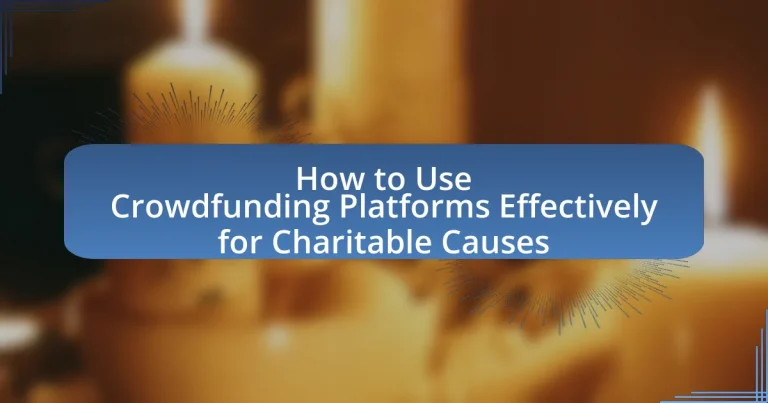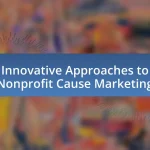Crowdfunding for charitable causes is a fundraising method that leverages small contributions from a large number of individuals, primarily through online platforms. This article explores the mechanics of crowdfunding, highlighting its effectiveness in mobilizing community support for various initiatives. Key elements of successful campaigns, including storytelling, clear goals, and community engagement, are discussed alongside different crowdfunding models such as donation-based and reward-based crowdfunding. The article also addresses the importance of transparency, strategies to enhance campaign success, and best practices for selecting crowdfunding platforms, ultimately providing charities with practical tips to optimize their fundraising efforts.
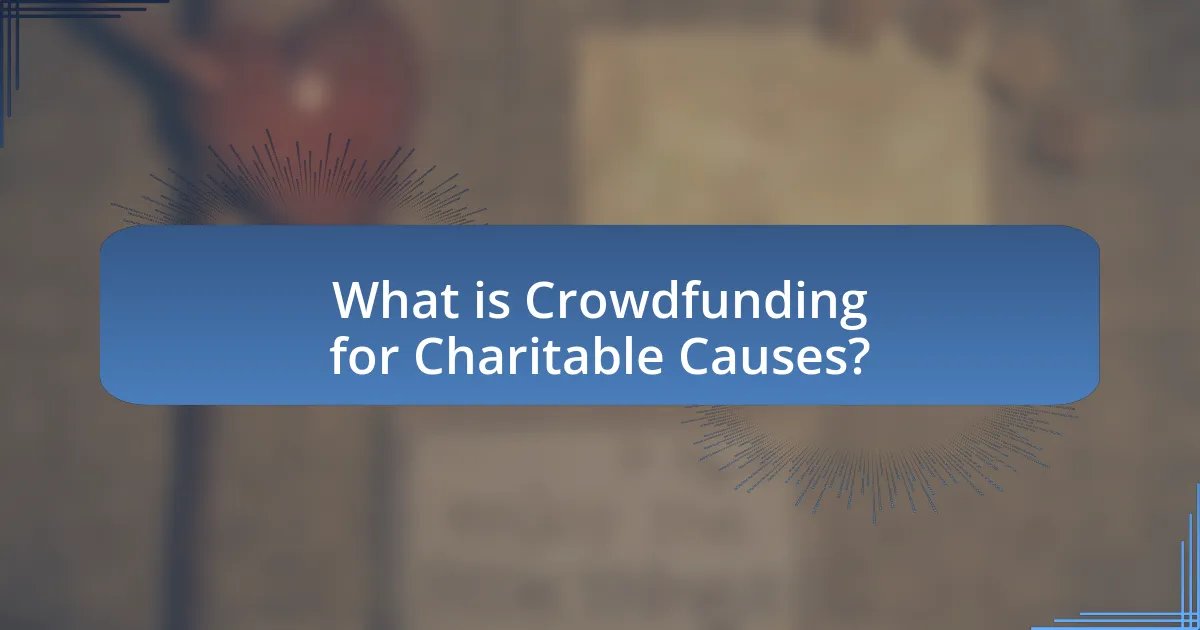
What is Crowdfunding for Charitable Causes?
Crowdfunding for charitable causes is a method of raising funds through small contributions from a large number of people, typically via online platforms. This approach allows individuals, organizations, or communities to gather financial support for specific projects, initiatives, or emergencies that benefit a charitable purpose. According to a report by Statista, crowdfunding in the charitable sector has seen significant growth, with platforms like GoFundMe and Kickstarter facilitating millions of dollars in donations annually. This model not only democratizes fundraising but also engages a broader audience in social impact efforts, making it an effective tool for addressing various societal needs.
How does crowdfunding work for charitable initiatives?
Crowdfunding for charitable initiatives involves raising small amounts of money from a large number of people, typically via online platforms. Charitable organizations or individuals create a campaign detailing their cause, set a funding goal, and share it through social media and other channels to attract donors. According to a report by the Nonprofit Finance Fund, 70% of nonprofits have used crowdfunding to support their missions, demonstrating its effectiveness in mobilizing community support. Donors contribute directly to the campaign, often receiving updates on the impact of their contributions, which fosters transparency and encourages further donations.
What are the key elements of a successful crowdfunding campaign?
The key elements of a successful crowdfunding campaign include a compelling story, a clear funding goal, effective marketing strategies, and strong community engagement. A compelling story captures the audience’s attention and connects emotionally, while a clear funding goal provides transparency and sets expectations for potential backers. Effective marketing strategies, such as social media promotion and email outreach, help to reach a wider audience, and strong community engagement fosters trust and encourages sharing among supporters. Research indicates that campaigns with these elements are more likely to meet or exceed their funding targets, as evidenced by a study from the University of Pennsylvania, which found that campaigns with a well-defined narrative and active social media presence raised 50% more than those without.
How do different crowdfunding models apply to charitable causes?
Different crowdfunding models apply to charitable causes by providing various mechanisms for raising funds, each suited to specific needs and goals. Donation-based crowdfunding allows individuals to contribute directly to a cause without expecting financial returns, making it ideal for charities seeking immediate support for projects or emergencies. Reward-based crowdfunding incentivizes contributions with non-monetary rewards, which can engage donors by offering them tangible benefits, thus enhancing community involvement in charitable initiatives. Equity crowdfunding, while less common in charitable contexts, enables supporters to invest in social enterprises that aim to generate social impact alongside financial returns, appealing to those interested in sustainable solutions. Research indicates that donation-based crowdfunding has seen significant growth, with platforms like GoFundMe raising over $9 billion for charitable causes since their inception, demonstrating the effectiveness of these models in mobilizing community support for various initiatives.
Why is crowdfunding important for charities?
Crowdfunding is important for charities because it provides a platform for raising funds from a large number of people, enabling organizations to reach their financial goals more effectively. This method democratizes fundraising, allowing charities to tap into a wider audience beyond traditional donors. According to a report by Statista, crowdfunding in the charity sector has seen significant growth, with the global crowdfunding market expected to reach over $300 billion by 2025. This growth indicates a shift in how charities can mobilize resources, making it easier to fund specific projects or initiatives directly aligned with their missions.
What advantages does crowdfunding provide over traditional fundraising?
Crowdfunding offers several advantages over traditional fundraising, primarily through broader reach, lower costs, and increased engagement. Crowdfunding platforms enable individuals and organizations to access a global audience, significantly expanding potential donor pools compared to localized traditional fundraising efforts. Additionally, crowdfunding typically incurs lower overhead costs, as it often eliminates the need for physical events and associated expenses. Furthermore, crowdfunding fosters greater engagement by allowing donors to interact directly with campaigns, share them on social media, and receive real-time updates, which enhances community involvement and support. These factors collectively contribute to the effectiveness of crowdfunding as a modern fundraising strategy.
How can crowdfunding enhance community engagement for charities?
Crowdfunding enhances community engagement for charities by fostering a sense of collective ownership and participation among community members. When individuals contribute to a crowdfunding campaign, they feel personally invested in the cause, which encourages them to share the campaign within their networks, amplifying outreach and support. Research indicates that campaigns with strong community ties can raise up to 50% more funds than those without, demonstrating the direct correlation between community involvement and fundraising success. Additionally, crowdfunding platforms often include social features that allow backers to comment, share updates, and interact with the charity, further strengthening community bonds and engagement.
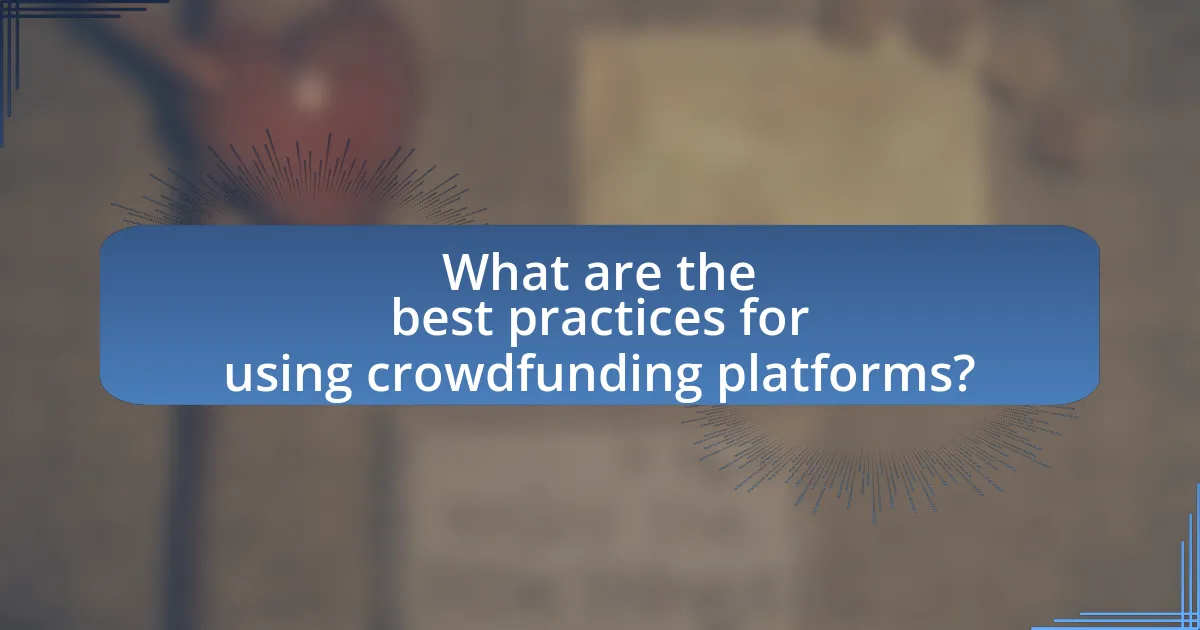
What are the best practices for using crowdfunding platforms?
The best practices for using crowdfunding platforms include setting clear goals, creating a compelling narrative, engaging with potential backers, and promoting the campaign effectively. Clear goals help backers understand the purpose and funding needs, while a compelling narrative captures attention and fosters emotional connections. Engaging with potential backers through updates and responses builds trust and community. Effective promotion across social media and email channels increases visibility; for instance, campaigns that utilize social media see a 50% higher success rate according to a study by the University of Pennsylvania.
How can charities choose the right crowdfunding platform?
Charities can choose the right crowdfunding platform by evaluating factors such as fees, audience reach, platform features, and support services. Analyzing the fee structure is crucial, as platforms may charge different percentages of funds raised; for instance, GoFundMe typically has no platform fee, while Kickstarter charges 5%. Audience reach is also important; platforms like Facebook Fundraising leverage social media for wider visibility. Additionally, features such as customizable campaign pages and integration with social media can enhance fundraising efforts. Support services, including customer service and resources for campaign optimization, further influence the decision. By considering these criteria, charities can select a platform that aligns with their fundraising goals and maximizes their impact.
What factors should be considered when selecting a platform?
When selecting a crowdfunding platform for charitable causes, key factors include fees, audience reach, ease of use, and available features. Fees impact the total funds raised, as platforms typically charge a percentage of donations; for example, platforms like GoFundMe charge around 2.9% plus $0.30 per donation. Audience reach is crucial because a platform with a larger user base can increase visibility and potential donations; Kickstarter, for instance, has millions of users. Ease of use affects both the campaign creator’s experience and donor engagement; platforms like Indiegogo offer user-friendly interfaces. Finally, available features such as social sharing tools and analytics can enhance campaign effectiveness, as evidenced by platforms that provide integrated marketing tools leading to higher engagement rates.
How do platform fees impact fundraising goals?
Platform fees directly reduce the total amount of funds available for charitable causes, impacting fundraising goals negatively. For instance, if a crowdfunding platform charges a 5% fee on donations, a campaign that raises $10,000 will only receive $9,500 after fees are deducted. This reduction can hinder the ability to meet specific financial targets, as less money is available for the intended purpose. Additionally, high platform fees may discourage potential donors, as they might prefer to contribute to campaigns where more of their donation goes directly to the cause rather than to administrative costs.
What strategies can increase the success of a crowdfunding campaign?
To increase the success of a crowdfunding campaign, effective strategies include building a strong narrative, leveraging social media, and engaging with backers. A compelling story captures the audience’s attention and fosters emotional connections, which can significantly enhance funding potential. Research indicates that campaigns with a well-crafted narrative raise 20% more funds than those without. Utilizing social media platforms expands reach and visibility, as campaigns promoted through these channels can attract up to 50% more backers. Additionally, actively engaging with backers through updates and responding to inquiries fosters trust and encourages further contributions, leading to a 30% increase in repeat donations.
How important is storytelling in crowdfunding for charities?
Storytelling is crucial in crowdfunding for charities as it significantly enhances emotional engagement and donor connection. Effective narratives can convey the mission, impact, and urgency of a cause, making potential donors more likely to contribute. Research indicates that campaigns with compelling stories raise 300% more funds than those without, highlighting the power of storytelling in motivating donations. By illustrating real-life experiences and outcomes, charities can foster trust and inspire action, ultimately driving successful fundraising efforts.
What role does social media play in promoting crowdfunding campaigns?
Social media plays a crucial role in promoting crowdfunding campaigns by providing a platform for widespread visibility and engagement. It enables campaign creators to share their stories, updates, and calls to action with a large audience, facilitating direct communication with potential backers. According to a study by the University of Pennsylvania, campaigns that effectively utilize social media can raise up to 50% more funds than those that do not. This is largely due to the ability of social media to foster community support and encourage sharing among users, amplifying the reach of the campaign.
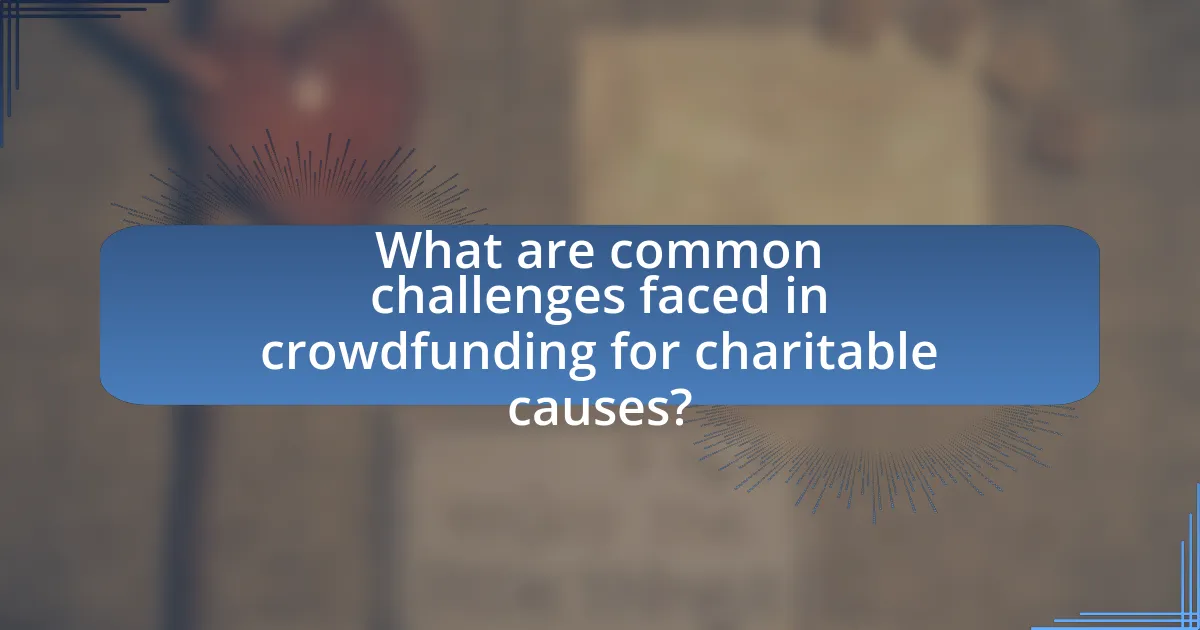
What are common challenges faced in crowdfunding for charitable causes?
Common challenges faced in crowdfunding for charitable causes include lack of visibility, donor fatigue, and trust issues. Lack of visibility arises when campaigns do not reach a broad audience, limiting potential contributions; studies show that campaigns with effective marketing strategies can raise up to 50% more funds. Donor fatigue occurs when potential donors feel overwhelmed by frequent requests for contributions, leading to decreased engagement; research indicates that repeated appeals can diminish donor response rates. Trust issues stem from skepticism about how funds will be used, which can deter contributions; a survey found that 70% of donors are concerned about transparency in fund allocation.
What obstacles might charities encounter during a crowdfunding campaign?
Charities may encounter several obstacles during a crowdfunding campaign, including lack of visibility, donor fatigue, and regulatory challenges. Lack of visibility can stem from insufficient marketing efforts, making it difficult for potential donors to discover the campaign. According to a study by the University of Pennsylvania, campaigns that do not effectively utilize social media and other promotional channels can see a significant drop in funding potential. Donor fatigue occurs when potential contributors feel overwhelmed by numerous requests for donations, leading to decreased engagement. Additionally, regulatory challenges, such as compliance with fundraising laws and tax regulations, can hinder a charity’s ability to operate effectively within the crowdfunding space. These obstacles can significantly impact the success of a crowdfunding initiative for charities.
How can charities effectively address donor skepticism?
Charities can effectively address donor skepticism by enhancing transparency and demonstrating impact. Providing detailed financial reports and clear information on how donations are utilized builds trust with potential donors. For instance, a study by the Charities Aid Foundation found that 73% of donors are more likely to give when they see evidence of the charity’s effectiveness. Additionally, sharing success stories and testimonials from beneficiaries can illustrate the tangible outcomes of donations, further alleviating skepticism.
What strategies can mitigate the risk of campaign failure?
To mitigate the risk of campaign failure in crowdfunding for charitable causes, it is essential to implement thorough planning and targeted outreach strategies. Conducting comprehensive market research helps identify the target audience and their preferences, ensuring that the campaign resonates with potential donors. Additionally, setting clear, achievable goals and milestones allows for tracking progress and maintaining momentum throughout the campaign.
Utilizing social media effectively can amplify reach and engagement, as platforms like Facebook and Instagram have proven to increase visibility for fundraising efforts. A study by the Nonprofit Research Collaborative found that organizations using social media for fundraising saw a 30% increase in donations compared to those that did not.
Moreover, creating compelling narratives and visuals that highlight the cause can evoke emotional responses, encouraging contributions. Regular updates and transparent communication with backers foster trust and loyalty, which are crucial for sustaining support. By combining these strategies, the likelihood of campaign success is significantly enhanced.
How can charities measure the success of their crowdfunding efforts?
Charities can measure the success of their crowdfunding efforts by analyzing key performance indicators (KPIs) such as total funds raised, number of donors, and engagement metrics. Total funds raised provides a direct measure of financial success, while the number of donors indicates the campaign’s reach and appeal. Engagement metrics, including social media shares and comments, reflect community involvement and interest. According to a study by the Nonprofit Finance Fund, successful crowdfunding campaigns typically see a 30% increase in donor engagement compared to traditional fundraising methods, highlighting the effectiveness of these metrics in assessing success.
What metrics should be tracked to evaluate campaign performance?
To evaluate campaign performance, key metrics include total funds raised, number of backers, average donation amount, conversion rate, and engagement rate. Total funds raised indicates the overall financial success of the campaign, while the number of backers reflects the level of community support. The average donation amount helps assess donor behavior, and the conversion rate measures the effectiveness of the campaign in turning visitors into backers. Lastly, the engagement rate, which can be tracked through social media shares and comments, provides insight into how well the campaign resonates with its audience. These metrics collectively offer a comprehensive view of a campaign’s effectiveness in achieving its fundraising goals.
How can feedback be used to improve future crowdfunding campaigns?
Feedback can be used to improve future crowdfunding campaigns by identifying strengths and weaknesses in campaign strategies. Analyzing feedback from backers can reveal what aspects of the campaign resonated with supporters, such as messaging, rewards, or marketing channels. For instance, a study by Indiegogo found that campaigns that actively sought and incorporated backer feedback saw a 20% increase in funding success rates. By implementing changes based on this feedback, campaign creators can enhance engagement, tailor their offerings, and ultimately increase their chances of reaching funding goals in subsequent campaigns.
What practical tips can enhance crowdfunding success for charities?
To enhance crowdfunding success for charities, organizations should focus on creating compelling narratives that resonate with potential donors. Engaging storytelling can significantly increase emotional connections, leading to higher donation rates. Research indicates that campaigns with strong narratives raise 20% more funds than those without. Additionally, charities should leverage social media to amplify their reach, as campaigns promoted through social platforms can see up to 30% more engagement. Establishing clear goals and transparent funding usage also builds trust, encouraging contributions; studies show that campaigns with specific funding targets are 50% more likely to succeed. Lastly, regular updates to backers keep them informed and engaged, fostering a sense of community and ongoing support.
